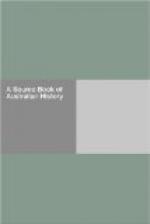We calculated that we were forty miles from the camp, in a S.W. direction, a fearful distance under our circumstances, since we could not hope to obtain relief for two days. Independently, however, of the state of the animals, our spirits were damped by the nature of the country, and the change which had taken place in the soil, upon which it was impossible that water could rest; while the general appearance of the interior showed how much it suffered from drought. On the other hand, although the waters of the river had become worse to the taste, the river itself had increased in size and stretched away to the westward, with all the uniformity of a magnificent canal, and gave every promise of increasing importance; while the pelicans were in such numbers upon it as to be quite dazzling to the eye. Considering, however, that perseverance would only involve us in extricable difficulties, and that it would also be useless to risk the horses, since we had gained a distance to which the bullocks could not have been brought I intimated my intention of giving up the further pursuit of the river, though it was with extreme reluctance that I did so.
As soon as we had bathed and finished our scanty meal, I took the bearings of D’Urban’s Group, and found them to be S.58 E. about thirty-three miles distant; and as we mounted our horses, I named the river the “Darling,” as a lasting memorial of the respect I bear the Governor.
I should be doing injustice to Mr. Hume and my men if I did not express my conviction that they were extremely unwilling to yield to circumstances, and that, had I determined on continuing the journey, they would have followed me with cheerfulness, whatever the consequences might have been.
EXPLORATION OF THE EASTERN RIVER SYSTEM
+Source.+—Expeditions in Australia (Sturt, 1833), Vol. II, pp. 6, 8-69, 85-86, 111, 151-187, 204-217, 219.
On his first expedition Sturt had proved that the interior was dry. He then attempted to find the destination of the Morumbidgee and the Darling. Travelling down the Morumbidgee he discovered the Murray and followed it to its termination, 1829.
Dec. 27th. M’Leay and I started at an early hour on an excursion of deeper interest than any we had as yet undertaken; to examine the reeds, not only for the purpose of ascertaining their extent, if possible, but also to guide us in our future measures. We rode some miles along the river side, but observed in it no signs either of increase or of exhaustion. Everything tended to strengthen my conviction that we were still far from the termination of the river. I was aware that my resolves must be instant, decisive, and immediately acted upon, as on firmness and promptitude at this crisis the success of the expedition depended. About noon I checked my horse, and rather to the surprise of my companion, intimated to him my intention of




